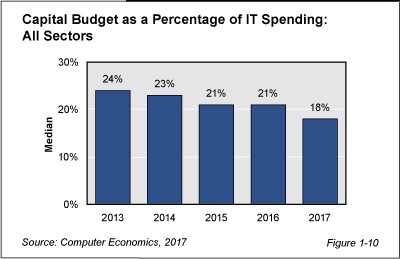IT organizations continue on a path of steady but modest growth in operational budgets, while capital budgets and hiring are essentially flat, according to the Computer Economics annual IT Spending and Staffing Benchmarks study for 2017/2018. These trends are tangible evidence of the effects of cloud computing on corporate IT budgets, says the research firm. The study finds that the greatest effect has been a steady decrease in the percent of total IT spending that goes toward the capital budget.
According to the findings, IT organizations have decreased capital spending from 24% of total IT spending in 2013 to 18% in 2017. For the most part, capital spending has held steady, while operational budgets have grown, leading to capital budgets making up a smaller part of the pie. The main reason for the shift from capex to opex is that cloud infrastructure and software as a service afford greater elasticity and do not require large capital investments to purchase computer hardware or software licenses, say CE researchers.
“Unless you are an IT equipment manufacturer, this is good news,” said David Wagner, vice president, research, at Computer Economics, based in Irvine, Calif. “The cloud transition is far from over, and we’re already seeing more efficient IT departments, particularly on a cost-per-user basis, which is at a new low. Business applications and network infrastructure are the top areas of new IT spending while the data center, for the first time, is at the bottom. We take this as a sign the cloud transformation is continuing in earnest.”
The study finds that the current environment of moderate growth in IT operational budgets with slow-to-no growth in IT staffing levels and IT capital budgets is good news for the long-term success of IT departments in that more of the IT budget will be in variable costs, increasing flexibility and making it easier to manage. There are also implications for IT staffing, with less than half of IT organizations planning to add IT staff this year, according to the study. Increases in IT headcount are becoming more modest in good times, with, hopefully, less severe cutbacks in bad times. While cloud computing and greater levels of automation are reducing the demand for lower level IT positions, the demand is increasing for skills at higher levels, such as business analysis, data analytics, project management, IT security, and vendor management.
The study sees positive signs that this “new normal” is working out well for IT departments, with IT executives finding ways to succeed despite slow-growing budgets. The number of respondents reporting that their budgets are inadequate dropped from 60% to only 52%. This is most likely due to the fact that new technologies, including cloud applications and cloud infrastructure, are allowing CIOs to more quickly and cheaply roll out new IT capabilities.
Where is IT spending focused this year? The survey shows that IT executives are investing more of their budgets in business applications, networking, security, and end-user devices. More evidence of this is the finding that data center spending is not much of a priority at all, as IT departments shift some of their workload off-premises and increase efficiency for what remains in the data center with virtualization and automation.










